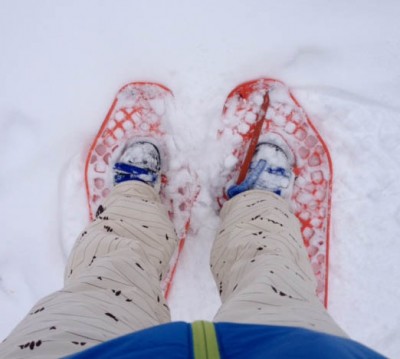Posted on February 16, 2016
Winter workouts and activities to stay fit in the colder months
Unless you’re a winter sports enthusiast, the sting of the cold air can make it much more tempting to stay inside with a cup of hot chocolate rather than get outdoors to exercise. This makes it especially difficult to combat those seasonal blues.
 Trying new winter workouts and activities — or dusting off some classics — can inspire a new pastime for you and your friends or family, while burning off any extra holiday calories that may have stuck around.
Trying new winter workouts and activities — or dusting off some classics — can inspire a new pastime for you and your friends or family, while burning off any extra holiday calories that may have stuck around.
Below, are fun ideas for winter workouts, inspired by the experts in Mary Free Bed Weight Management Program:
Snowshoeing — Hike some trails with a pair of snowshoes and make sure to grab a set of poles for extra stability. In an hour of snowshoeing, an individual weighing 150 pounds can burn about 450 calories.
Cross-country skiing — The alternative to hiking with snowshoes is to glide the trails on cross-country skis. Traveling 4 miles per hour will burn about 475* calories.
Tubing or sledding — Channel your inner child for this fun winter activity. Simply find a good hill and bring your tube or sled to burn an average of 300-400* calories in one hour. Burn extra calories by walking your tube or sled back up the hill, instead of using that convenient lift if you’re at a resort. Helmets are a good idea for all ages.
Downhill skiing or snowboarding — Downhill skiing or snowboarding at a light effort can burn about 300* calories per hour. And again, don’t forget a helmet.
Ice skating — Take the whole family to a local ice skating rink, rent skates and have some fun. Stay close to the railing or ask for a stabilizer for extra support if you haven’t skated in a while (or ever). On average, you’ll burn about 300-500* calories during one hour of ice skating, depending on the intensity.
Shoveling snow — Although most may not consider this a fun activity and would rather use that convenient snow blower, the dreaded half hour of shoveling can burn about 200* calories. Always be sure to practice safe shoveling, lifting with your legs as to not injure your back. The National Safety Council offers additional tips to help you protect your health while taking care of your sidewalks and driveway.
February also happens to be American Heart Month, gently reminding us about the importance of heart health. Trudging through snow in heavy snow gear is a lot harder on your body and cardiovascular system compared to some warmer weather activities. Ask your doctor before starting any new winter workouts.
Always be aware of your heart rate, the intensity of the activity and keep a form of hydration on hand at all times. Taking your time and walking a bit slower (and safer!) to enjoy the scenery and the moment with friends and family should be an extra motivator to get out and enjoy all of what West Michigan has to offer in the winter.
*Individual calorie burn will vary based on weight, body composition and activity intensity.





